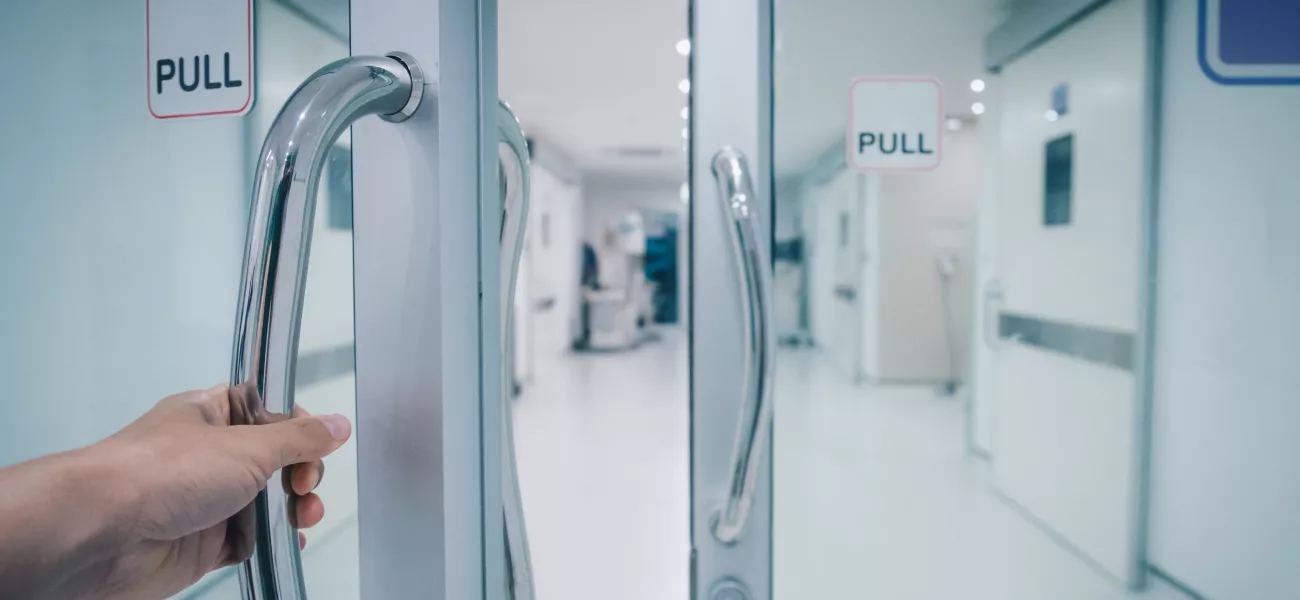
Over the past few years, healthcare facilities have been under immense pressure. While the pandemic has now eased, many hospitals and long-term care facilities remain resource-strapped and understaffed. How can you continue to provide quality care amid rising staff shortages? With limited funding, what can you invest in to help your facilities long term?
As a healthcare provider, you are likely searching for viable solutions to not only improve patient care, but to ensure their safety. Network technology is a core component here. Hospitals have already been relying on audio, video, and analytics as part of remote patient monitoring to safeguard patients. Now, many are turning to these solutions to help manage access to their facilities.
This blog looks specifically at network intercoms as an access control solution, and how they can be used to keep your patients safe and secure.
Improving patient care
Access control solutions such as network intercoms can act as a force multiplier for healthcare facilities. Hospitals are some of the most difficult institutions to operate, the day-to-day logistics involve a high turnaround of patients and staff which can lead to inefficiencies. With an advanced access control system in place to manage entrants into and out of premises, you can improve operational efficiency and in turn, patient care.
Designed to combine video, on-edge analytics, two-way communication and remote entry into a single device for secure access to your facility, network intercoms can be easily integrated into your existing video or audio systems and IP network. They can also be coupled with a third-party access control system to automatically open and shut doors, removing the need for patients, visitors or staff to touch surfaces.
A touchless solution like this is particularly beneficial when it comes to keeping your patients safe and healthy. Network intercoms enable frictionless access, which reduces the amount of shared contact points. Eliminating the need for keypads and other physical forms of access, and relying instead on audio capabilities, this low touch technology can mitigate the spread of germs and infectious diseases to protect your patients.
Controlling access in healthcare
Within a hospital setting, there a number of areas that need to be well-secured. These include staff-only areas holding medicines or critical technology, restricted units with immune compromised patients, surgical areas, and so on. Integrating network intercoms as part of an access control system can provide critical security measures, enabling you to protect against unauthorized internal access and to ensure patient safety.
Using network intercoms outside your healthcare facility can also further enhance security. Integrated with other access control solutions, it’s possible to automatically grant or deny access. For example, a forced or propped open door can automatically trigger an alarm, which then alerts your security staff to a potential issue. These capabilities can be beneficial for resource-strapped healthcare providers, particularly at times when staffing levels may be low.
Network intercoms can also prove invaluable when it comes to granting patients access to premises. Placing intercoms outside hospitals is soon to become law from 2024 in Massachusetts, US, under ‘Laura’s Law’. This is named after Laura Levis, a patient who collapsed from an asthma attack outside a hospital because she couldn’t gain access. While this is an isolated incident, it demonstrates the importance of implementing technology to provide frictionless access for patients in need of care.
The implementation of Laura’s Law will enforce hospitals to improve lighting, signage, wayfinding, and monitoring systems to ensure smooth access to emergency rooms for patients in critical situations. Intercom systems serve as a crucial component here, facilitating direct communication between individuals outside the secure facility and the dedicated healthcare staff within. During emergencies, patients can rely on intercom systems to promptly notify staff, effectively communicate their urgent needs, and receive immediate assistance.
Selecting the right solution
The type of solution you need depends on your facility. For small, basic installations a network intercom that can integrate with a QR code reader to open doors remotely could be most suitable. A QR code with a specific date and time of validity can be shared with a patient, healthcare professional or visitor in advance, ready for them to present to the intercom. With optimized image quality and smart analytics, the intercom can process the credential. If it is recognized, this data is shared within your wider access control system, signaling the network door controller to subsequently grant them access.
For more advanced security requirements, you’ll likely need a more robust solution. This will take advantage of the latest analytics and integrate seamlessly with other systems, such as intrusion detection, HVAC unit, HR systems, etc. You can also utilize a network surveillance camera and network speaker to further enhance these capabilities. If a patient or visitor enters a predefined area, for example, the solution will automatically trigger a message, adding an additional layer of security to your hospital premises. The possibilities are endless.
You can also opt for network intercoms with integrated cyber protection to help prevent unauthorized access and safeguard the system. For example, an industry-accepted RSA public-key encryption method can be integrated in your network intercom. This signed firmware feature allows you to sign a firmware image with a private key. When firmware has this signature attached to it, a device will validate it before accepting and installing it. If the device detects that the firmware integrity is compromised, it will reject the upgrade – thereby protecting your system and patient data.
Network intercoms for today, tomorrow…and years to come
It’s crucial to note that the solution you install shouldn’t be a short-term fix. You should adopt it with the intention of it being a long-term answer that can help improve operations and patient care, now and in the future. The question, then becomes, where do you start? Look into partnering with a provider that will work with you by understanding your facility’s unique needs. The network solution should be adaptable, flexible and scalable, and it should integrate with other systems.
